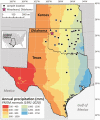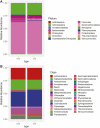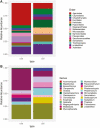Interactions with fungi vary among Tripsacum dactyloides genotypes from across a precipitation gradient
- PMID: 38028745
- PMCID: PMC10667659
- DOI: 10.1093/aobpla/plad072
Interactions with fungi vary among Tripsacum dactyloides genotypes from across a precipitation gradient
Abstract
Plant-associated microbes, specifically fungal endophytes, augment the ability of many grasses to adapt to extreme environmental conditions. Tripsacum dactyloides (Eastern gamagrass) is a perennial, drought-tolerant grass native to the tallgrass prairies of the central USA. The extent to which the microbiome of T. dactyloides contributes to its drought tolerance is unknown. Ninety-seven genotypes of T. dactyloides were collected from native populations across an east-west precipitation gradient in Kansas, Oklahoma and Texas, and then grown together in a common garden for over 20 years. Root and leaf samples were visually examined for fungal density. Because fungal endophytes confer drought-tolerant capabilities to their host plants, we expected to find higher densities of fungal endophytes in plants from western, drier regions, compared to plants from eastern, wetter regions. Results confirmed a negative correlation between endophyte densities in roots and precipitation at the genotype's original location (r = -0.21 P = 0.04). Our analyses reveal that the host genotype's origin along the precipitation gradient predicts the absolute abundance of symbionts in the root, but not the relative abundances of particular organisms or the overall community composition. Overall, these results demonstrate that genetic variation for plant-microbe interactions can reflect historical environment, and reinforce the importance of considering plant genotype in conservation and restoration work in tallgrass prairie ecosystems.
Keywords: Endophytes; Tripsacum dactyloides; fungi; local adaptation; perennial; plant microbiome; precipitation; stress gradient hypothesis; tallgrass prairie.
© The Author(s) 2023. Published by Oxford University Press on behalf of the Annals of Botany Company.
Conflict of interest statement
The authors declare that the research was conducted in the absence of any commercial or financial relationships that could be construed as a potential conflict of interest. Any opinion, findings and conclusions or recommendations expressed in this material are those of the authors and do not necessarily reflect the views of the National Science Foundation.
Figures









Similar articles
-
Climate affects symbiotic fungal endophyte diversity and performance.Am J Bot. 2013 Jul;100(7):1435-44. doi: 10.3732/ajb.1200568. Epub 2013 Jun 28. Am J Bot. 2013. PMID: 23813587
-
Characterization of the complete chloroplast genome of the Eastern gamagrass, Tripsacum dactyloides.Mitochondrial DNA B Resour. 2017 Dec 7;2(2):910-912. doi: 10.1080/23802359.2017.1413312. Mitochondrial DNA B Resour. 2017. PMID: 33474032 Free PMC article.
-
Water relations and growth of three grasses during wet and drought years in a tallgrass prairie.Oecologia. 1984 Dec;65(1):35-43. doi: 10.1007/BF00384460. Oecologia. 1984. PMID: 28312107
-
A Systematic Review on the Effects of Epichloë Fungal Endophytes on Drought Tolerance in Cool-Season Grasses.Front Plant Sci. 2021 Mar 24;12:644731. doi: 10.3389/fpls.2021.644731. eCollection 2021. Front Plant Sci. 2021. PMID: 33841472 Free PMC article.
-
Molecular mechanisms in grass-Epichloë interactions: towards endophyte driven farming to improve plant fitness and immunity.World J Microbiol Biotechnol. 2020 Jun 19;36(7):92. doi: 10.1007/s11274-020-02868-5. World J Microbiol Biotechnol. 2020. PMID: 32562008 Review.
Cited by
-
Between Two Extremes: Tripsacum dactyloides Root Anatomical Responses to Drought and Waterlogging.Plant Direct. 2025 Jul 19;9(7):e70097. doi: 10.1002/pld3.70097. eCollection 2025 Jul. Plant Direct. 2025. PMID: 40687876 Free PMC article.
-
Intraspecific plant-soil feedbacks alter root traits in a perennial grass.bioRxiv [Preprint]. 2025 Mar 14:2025.03.11.642669. doi: 10.1101/2025.03.11.642669. bioRxiv. 2025. PMID: 40161764 Free PMC article. Preprint.
References
-
- Ali SZ, Sandhya V, Grover M, Kishore N, Rao LV, Venkateswarlu B.. 2009. Pseudomonas sp strain AKM-P6 enhances tolerance of sorghum seedlings to elevated temperatures. Biology and Fertility of Soils 46:45–55.
-
- Apprill A, McNally S, Parsons R, Weber L.. 2015. Minor revision to V4 region SSU rRNA 806R gene primer greatly increases detection of SAR11 bacterioplankton. Aquatic Microbial Ecology 75:129–137.
-
- Balting DF, AghaKouchak A, Lohmann G, Ionita M.. 2021. Northern hemisphere drought risk in a warming climate. NPJ Climate and Atmospheric Science 4:1–13.
-
- Barassi CA, Ayrault G, Creus CM, Sueldo RJ, Sobrero MT.. 2006. Seed inoculation with Azospirillum mitigates NaCl effects on lettuce. Scientia Horticulturae 109:8–14.
-
- Barney JN, Mann JJ, Kyser GB, Blumwald E, Van Deynze A, DiTomaso JM.. 2009. Tolerance of switchgrass to extreme soil moisture stress: ecological implications. Plant Science 177:724–732.
LinkOut - more resources
Full Text Sources

